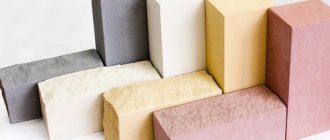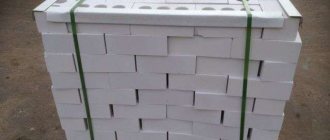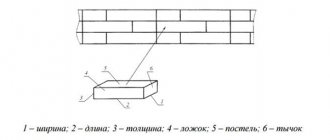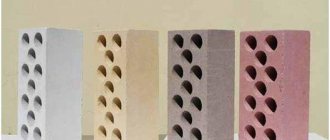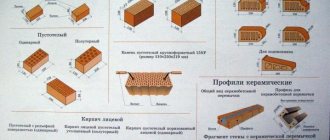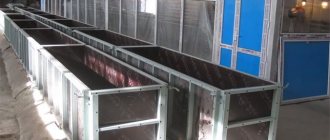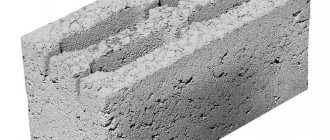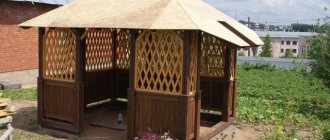Sand-lime brick (timber, briquettes, building material) is a popular building material that has found its wide application in all areas. To build a wall or even a simple partition, you need to be guided by the characteristic features and indicators of height, length, width (W/L/H).
The material has found its application in the construction of low-rise buildings and is suitable for the construction of fences. The material stands out for its resistance to cold, strength and low thermal conductivity.
Dimensions of white sand-lime brick
White brick wall
Classic sizes are designated by the abbreviation 1NF according to the state standard. It is considered the most purchased and in demand, given the thickness of the dressing. This indicator is important for the construction of load-bearing walls. The size of the white brick is standard , as well as its shape, which is distinguished by the following comparison of sides:
- timber length (spoon area) 250 millimeters;
- beam width (poke area) 120 millimeters;
- height (thickness) 65 millimeters.
For one cubic meter of masonry, the consumption will be over 500 bars (standard size and type). Timber with a solid and hollow structure is also available on the market. The mass of the first is a multiple of three and a half kg, the second is a multiple of two kilograms and one hundred grams.
Brick formatting
In general, the formats of all types of artificial stones, regardless of the material of manufacture and purpose, have the same standard, and the size range can be limited or expanded at the discretion of the manufacturer. Naturally, we are talking about Russian standards, since foreign manufacturers, whose products are also numerous on our market, are guided by the standards of their countries.
Therefore, we will first consider all possible formats that are prescribed by Russian GOSTs.
Table 1. Brick formats according to GOST
| Format name | Dimensions and application features |
| 1 SF | This is the main size, single (1 NF), in which both regular and front products are made. All other formats are linked to it. |
| 1.4 NF | This option is called one and a half and is designated as 1.4 NF. With the same length and width, this brick is thicker and has a height of not 65, but 88 mm. |
| 2.1 NF | In this case, an increase in height is also applied, which is already twice the corresponding size of the single format. That's why this brick is called double. |
| 0.8 NF | In this picture the dimensions are not indicated, but even visually it is clear that it has a smaller height. For the 0.8 NF format it is 55 mm, all other parameters are the same as for the above options. |
| 0.7 NF | Above were presented formats where variations concerned only the height of the brick. At 0.7 NF it is standard, but the width has been changed downward. Thus, with a standard length and height, such products have a width of not 120, but 85 mm. This allows you to reduce the thickness of the facing layer of the masonry, and thereby reduce its weight. |
| 0.5 NF | The 0.5 NF format is the longitudinal half of a full-size brick. This option is very convenient for continuous cladding (without a ventilation gap), and is also excellent for interior work. |
The table shows the main parameters of bricks produced according to Russian standards. If you notice, with variations in height and width, their length remains the same (250 mm). However, it is also planned to produce modular products with a length increased to 288 mm. The 1.3 NF format also has an increased width (138 mm) , and a standard height of 65 mm. There is a size option designated 1.8 NF, which also has an increased thickness (88 mm).
For imported bricks, for example, those made in Germany, the main parameters for length are 240 mm and width 115 mm (in the EURO version 100 mm ). Thickness is available in four options: 52 mm (DF); 65 mm (RF); 71 mm (NF) and 113 mm (2DF) . Belgian hand-molded clinker has a WFD format - with a thickness of 65 mm, a length of 215 and a width of 100 mm.
EURO format
So, when choosing a brick to decorate a building - especially if it will be involved in laying out the front verst, look carefully at the dimensions and select them so that it is convenient to work.
On a note. During construction, the length of the walls is determined based on the size of the masonry material, taking into account the mortar joints.
Video - Russian brick formats
White brick size in centimeters
Diagram and name of brick elements
One-and-a-half-size bars are used to ensure quick laying. The 1.4NF briquette is characterized by the following dimensions L/W/H - 25*12*88 mm. A cubic meter of masonry is more than 370 briquettes of a given size. There are solid stones and stones with voids. The weight of the first is five kg, and the second - four kg.
Double bar. When using 2.1NF, masonry is carried out very quickly and efficiently. This is a silicate-based stone with the following dimensions L/W/H – 250*120*138 mm. According to the characteristics of the space occupied by the material, it is identical to 2 stones of the classical structure. One cubic meter of masonry contains about 250 double bars. There are solid stones and stones with voids. The weight of the first is approximately 7.8 kg, and the second - more than 6.5 kg.
Red brick
Red brick is the most common and used building material . This versatile material is considered very ancient. They are used for laying foundations, building stairs, constructing walls, fences, and arranging basements and basements. With its help, stoves and fireplaces are installed.
Red brick can be ordinary and facing.
Ordinary material is used for installing walls, constructing partitions, and laying facades (with the condition of subsequent cladding). Ordinary material has a high level of strength along with low requirements for appearance. So, chips and cracks are quite acceptable, provided that they do not affect the quality.
Facing bricks are used to decorate buildings. It creates a flat surface, as a result of which it is placed both outside and inside. Decorative brick is also called facade brick because of these data. The standard sizes of facing bricks are equal to ordinary red ones. However, there are handmade objects with non-standard dimensions: for example, 210 x 100 x 50 mm, 210 x 100 x 65 mm. Due to the fact that they are not mass-produced, but individually, their price is correspondingly high.
Kiln brick is a separate category: 250 x 125 x 65 mm. This is a fire-resistant material, and high demands are placed on it. All bricks are the same size. To check for quality, tap it: a sound should appear, as when tapping metal. When split, it breaks into separate pieces. The price of refractory material is higher.
Taking into account the size, red brick is divided into types:
- single;
- one and a half;
- double.
8 /Alt: Types of red brick by size. Title: How ceramic bricks vary in size/
The standard dimensions of red brick are usually as follows:
- length – 250mm;
- width – 125mm;
- brick height – 65mm.
Ceramic bricks are produced in the following forms:
- hollow;
- full-bodied;
- porous.
The voids in ceramic bricks vary in their configuration:
- cylinder with a diameter of up to 20 mm;
- square with a side up to 20 mm;
- gap up to 16 mm.
Horizontal voids have an arbitrary shape.
How much a red brick weighs depends on how full it is:
- full-bodied – up to 3.6 kg;
- hollow – 2.3-2.7 kg.
Advantages of ceramic bricks
Red brick has a lot of undeniable advantages:
- lasting;
- with high density and wear resistance;
- with good sound insulation;
- low level of moisture absorption;
- environmentally friendly material;
- unaffected by climatic conditions
The disadvantages of brick include, first of all, its high price, as well as possible efflorescence. In addition, it is important that all bricks used come from the same batch, otherwise differences will be visible.
One and a half brick
The thickness of a one-and-a-half brick is 1.35 times greater than a single standard. Dimensions: 250 mm x 120 mm x 88 mm. The properties of this material allow masonry to be done in an accelerated manner. The weight of hollow brick is 3-3.3 kg, solid brick is 4-4.3 kg.
Double brick
During the period of rapid construction, there was a severe shortage of building materials that had such high data so that multidisciplinary construction projects could be quickly put into operation. In order to solve this issue, a double red brick with dimensions of 250 x 120 x 138 mm was introduced. The thickness of such a red brick is 2.1 times greater than the usual width of a brick with standard parameters.
However, this significantly increased the mass of the brick to 7.2 kg and, as a result, significantly complicated the masonry construction work. The way out of the situation was the production of double hollow bricks. So his weight decreased to 4.6-5 kg.
Dimensions of standard white and other types of bricks
Less popular are bars of the following categories:
- euro (0.7NF). L/W/H: 250*85*65 mm;
- with a single module (1.3NF) L/W/H: 288*138*65 mm, the product is shaped like a wedge, which is used for the construction of vaults and arches.
Type of white sand-lime brick
The size of the bars does not always have to be exact.
Here, minimal errors in L/W/H of up to three millimeters are allowed. Sometimes weight inaccuracies can vary by up to 5mm. This is due to the absorption procedure of the silicate-based mixture during production. If standard briquettes were used during the construction of the structure, the property will be durable and stable.
Standard sizes of white brick
The size of the white facing brick must always be taken into account. This indicator is calculated before starting work. Advantages : resistance of the material to changes in thermometer columns, environmental friendliness (it is made from natural ingredients). You can add to all this an acceptable cost, in comparison with its ceramic counterpart. Despite this, the material cannot boast of a certain resistance to elevated temperatures. It is not able to withstand temperatures greater than 450 degrees.
The material does not stand out for its water resistance. It is not recommended for use when laying bathing areas and other objects that will come into contact with moisture. But the material feels good when the temperature jumps. It is used for the construction of real estate in cities with frosty and windy cyclones.
Construction of a white brick house
Silicate-based timber is the most popular and purchased material for construction. To ensure that everything goes consistently during the construction of houses, companies producing bars and building materials are required to adhere to established dimensions. All types of bars, as well as materials, have their own state standards. If all companies followed their design and dimensions, without paying attention to classical standards, then at the stage of building houses, turmoil would begin, which would undoubtedly lead to the destruction of load-bearing structures, partitions and houses.
Diagram: dimensions of white sand-lime brick
In the CIS countries, a single rule was established for bars in 27 of the 20th century, which provided for an updated format (NF) of the bar, and all other dimensions are considered derivatives of the classics.
To design an object, at the calculation stage, it is necessary to take into account the existing dimensions of building materials. The thickness of the supporting structures is a multiple of the dimensions of the bars that are used at any stage of construction. Do not forget about the thickness of the ball of the binding emulsion. Therefore, it is necessary to follow the rules at any stage of the production of white bars.
The dimensions of white building bricks are called:
- The 2 longest sides are “bed”;
- 2 middle sides - “spoon”;
- 2 minimal sides - “poke”.
Regardless of the working method used, the “functional” area of the bar is the “bed”.
The classic one is a single block (1NF), L/W/H. Its size is 25*12*6.5 centimeters. This specificity is convenient for using the material both across and along the masonry. This will improve the connection of the bars and strengthen the structure. For one cubic meter of walls made of single bars, over 500 units of material are used.
Bricks come in a variety of sizes
In addition to the above indicators, materials of the following dimensions are produced:
- white one-and-a-half brick dimensions (its coefficient is not 1.5, but 1.4NF);
- double. It is often called a stone, because this name is prescribed in domestic standards.
Regarding a single bar: to create a one-and-a-half double shape, only its height changes (in other words, the area between the “spoon” and the “poke” is lengthened). At the same time, the dimensions and the “bed” indicator do not change. One-and-a-half bars L/W/H: 25*12*8.8 cm. It is made with voids, and thanks to this, the work of masons is made easier, because the weight of other materials will be almost 5 kg.
Double block L/W/H H: 25*12*13.8 cm. In terms of volume, it is equal to a pair of single building materials, taking into account the thickness of the masonry ball. The weight of the bar is over seven kilograms. More than 250 pieces are used per cubic meter. It is most often produced with voids, which reduces its weight to a kilogram.
White brick houses look unusual
Types of facing bricks
Finishing brick is associated with the beautiful facade of a massive, tall building. But, in addition to the external decoration of a residential building or office building, pillars and columns of fences enclosing structures are built from such products; arches, gazebos, small architectural forms, even benches in parks are decorated with facing bricks. Any brick has a rectangular shape, of which two sides have a high-quality decorative surface - a spoon and a poke. This is the face of the product, that part of it that will look out onto the street.
There are several main types:
- Ceramic - exists with internal cavities, hollow and solid. The hollow one has less weight, and when chosen, the load on the foundation will be less.
- Clinker brick is the densest brick; due to the technological features of production, it has a very dense structure and has one of the highest moisture and frost resistance indicators.
- Hyper-pressed - it contains only clay and sand, in its cut it is very similar to natural stone due to the beautiful expressive chipping.
- Silicate brick is the cheapest brick, but in decorative terms it is inferior to other options.
Classic sizes and scope of application
The bar discussed in the article is a building material that is actively used in the construction of load-bearing structures. It is used for the construction of cylindrical pillars and arched arches. The product has a specific, doubled service life. As a result, load-bearing structures are classified as sustainable. For example, the service life of a foundation based on bars is not limited by anything.
But the block stands out from other analogues with its precise, established dimensions and organic appearance.
- Peculiarities.
The white block is produced using standard technology. For this, a silicate base is used, which is supplemented with calcium oxide, natural rounded sand and mineral additives. The main advantage of the bar is environmental friendliness.
The bar in question is distinguished by its sound insulation, which allows it to be used for the construction of load-bearing structures. Silicate-based bars are in many ways superior to their ceramic counterparts. This is due to their positive characteristics:
- specified strength, as well as resistance to sub-zero temperatures;
- undemanding;
- maximum stability;
- large assortment and types of shades.
But, like other materials for construction, white block is characterized by its disadvantages. For example, if we compare the material with its ceramic counterpart, the first stands out for its minimal level of resistance to increased thermometer readings and to water droplets.
Solid and hollow materials are used in the construction of houses. The latter are characterized by maximum thermal insulation characteristics that concentrate heat energy. They are used in the construction of houses to reduce the force on the foundation.
The percentage of voids often varies among different types of lumber. Fourteenth class timber, with thirty percent voids, is distinguished by increased heat conductivity. Due to this, it is used for fireplace masonry.
The main advantage of the white bar is obvious. Even supporting structures of minimal thickness, laid out in one ball, are distinguished by the same characteristics of thermal and sound insulation. They are often compared to thick ceramic materials that are laid out in several rows.
How much does sand-lime brick weigh?
Sand-lime brick belongs to the category of artificial building materials for the construction of vertical enclosing structures. The characteristics are excellent, the scope of application is wide, but do not forget that the type of foundation or supporting elements depends on such a parameter as the mass of white brick. Therefore, even for the simplest calculations you need to know the weight.
Types and characteristics
White brick is produced using a non-firing method from a mixture of lime binder, silica filler (quartz sand, fly ash, sludge, etc.) and a small amount of water to moisten the mixture. Under production conditions, raw materials are pressed and autoclaved. Due to this, the finished block gains the required parameters:
1. Compressive strength is marked as M75-M300.
2. Thermal conductivity – up to 0.87 W/m*K.
3. Frost resistance: withstands from 15 to 50 complete freeze-thaw cycles when completely immersed in water.
4. Density: porous or light up to 1500 kg/m³. Products with an index exceeding this indicator are called dense.
5. Water absorption – 6-16%.
The factories produce silicate blocks of the following dimensions:
- Single: 250x120x65 mm.
- One and a half or thickened: 250x12x88.
- Double: 250x120x103.
- Embossed: 250x90x65.
According to the area of application, a distinction is made between working or ordinary bricks and facing bricks. The latter is used for finishing facades, foundations, basements, and fences.
The structure for all sizes is typical:
- solid or monolithic product;
- hollow products, with a void content of up to 15% (3-hollow), 25% (11-hollow) and 31% (14-hollow).
White brick produced in accordance with GOST 379-95 “Silicate bricks and stones” must have a standard mass according to the table below.
The data from the table is adjusted for the weight of auxiliary materials. That is, for example, the weight of one one-and-a-half solid sand-lime brick, made according to the basic recipe from lime and sand, is 4.2 kg/piece. The total weight of the building material laid on a Euro pallet is 840 kg, but the pallet itself, protective film and fixing belts are added to this. Accordingly, the cargo prepared for transportation will weigh approximately 846 kg.
The weight of a hollow silicate block 250x120x88 is less than its solid counterpart precisely due to the cracks, but during the construction process they will be filled with mortar, so the total mass of the masonry will increase significantly. This must also be taken into account when calculating the project plan.
Before purchasing, you need to carefully examine the offered product. The surface must be hard, smooth, without chips, hewn corners, cracks and cavities. If the product crumbles in your hand or is slightly dented, it means that it was over-dried or under-dried, so it is not suitable for building walls - it will quickly collapse.
Weight and dimensions of white silicate bars according to the state standard
The silicate-based block is produced in a rectangular shape according to established, defined shapes and dimensions. The classic sizes of white silicate bars are adjusted according to the state standard. Even minimal deviations at any of the production stages are prohibited. This concerns the shape of the material itself. The dimensions and weight of the bars may vary depending on the type and its purpose.
The sizes of white bricks vary dramatically
According to technical rules approved by the state, there are 7 classes of bars. Hollow - characterized by lower weight and lower pricing when compared with dense material of the same class. Dimensions of white sand-lime brick one and a half or thick solid - 250*120*88 mm. Approximate weight – up to 5 kg. Bars measuring 250*120*138 mm are in demand and have found wide application. They are called double and weigh on average up to 8 kg.
Price for sand-lime white brick
White sand-lime brick
Video - Sand-lime brick: its pros and cons
In the field of industrial construction of facilities, it is customary to pay attention not to the volume of an individual bar, but to the total specific weight of a cubic meter of complete installation. It even takes into account the emulsion for gluing parts and the solution. Thanks to this, it is possible to calculate the total load on the base of the structure and make important adjustments at any stage of construction. It is important to pay attention to the type of bar used, its dimensions, the presence of voids and the thickness of the adhesive emulsion. The specific gravity of a cubic meter ranges from 670 – 2100 kilograms.
Red brick, sizes and varieties and defects
The dimensions of ordinary red brick are standardized by the requirements of GOST 530-2007, products are produced in the following standard sizes:
- Normal format, also known as single, the dimensions of an ordinary red brick are 250x120x65 mm;
- One and a half, thickened, in this case the thickness is increased, the remaining overall dimensions remain the same - 250x120x88 mm;
- Double, large format, overall dimensions – 250x120x138 mm;
- Modular, normal format, overall dimensions 288x138x65;
- “Euro” is a standard that came from Europe, has several types, the most famous size is 250x85x65 mm, this standard is also prescribed in GOST.
It should be noted that GOST allows the execution of bricks with deviations from the standard. Therefore, the dimensions of the red brick may differ slightly from the control dimensions.
“Effective”, also known as hollow brick, the structure of the ceramics is clearly visible
Separately, it is necessary to note wedge-shaped products intended for assembling vaults and arches; this type of product is heat-resistant and has a narrowed shape along the edges.
Kiln wedge brick
Dimensions of standard red brick
The dimensions of this building material are fully regulated by GOST; the height of the red brick may vary depending on the operating conditions and its purpose, within the limits and dimensions provided for by the system of state standards.
The dimensions of hollow and solid red bricks are similar; in this respect, only the scope of their use differs.
Slotted or hollow, it is actively used for filling openings in monolithic and frame structures, assembling walls, creating partitions, while solid is used under conditions of high loads: the foundation of a house, basement floors, load-bearing walls.
Dimensions of red facing bricks
Facing or facing bricks are used for external laying and decorative finishing of walls of buildings. The design and size of the facing brick is selected based on the project.
The size of a single facing brick is completely similar to the standard size - 250x120x65 or “Euro” 250x85x65 mm.
Dimensions and designations
Dimensions of red stove bricks
Kiln bricks are distinguished from ordinary bricks by their ability to withstand the effects of open flames and high temperatures for a long time; their area of operation is the creation of devices operating under high temperature loads, the lining of such structures and equipment operating under the influence of open flames. There are refractory red and fireclay bricks.
The price of red stove brick is usually higher than that of ordinary brick. This is a result of the fact that different raw materials and technologies are used to manufacture these products.
The overall size of stove bricks, unlike other types, can be divided into two types:
- Rectangular products with dimensions of single and thickened bricks 250x120x65 mm and 250x120x88 mm;
- Wedge-shaped products in accordance with GOST 8426-75, products of special shape: radial-longitudinal and radial-transverse are distinguished.
Red brick for the foundation, dimensions and features
To lay a foundation, bricks must have increased moisture resistance parameters and reduced water absorption, since the foundation is most susceptible to moisture. The overall size of ordinary red brick is selected based on the technical requirements of the house project. In addition, the products used to construct the foundation must have high load-bearing characteristics, due to the fact that the foundation accounts for most of the load-bearing load of the structure.
When choosing a material for basement floors, you need to pay attention to the choice of material according to physical parameters: frost resistance, moisture permeability and others. Strength is also extremely important; the product in the masonry will bear the entire weight of the structure
For the foundation, it is necessary to select high-quality, well-burnt material, without defects arising from violations of the technology of its production and storage.
It is recommended to use ordinary solid bricks to construct the foundation. Dimensions – 250x120x65 mm single and 250x120x88 thick. The double size of red brick for the plinth is rarely used.
Fold down the oven? Easily!
Standard white sand-lime brick size and physical characteristics
White bricks vary not only in size, but also in density
Many characteristics of silicate bars must be taken into account during construction. The main component is the ratio of the mass of the block to the volume it occupies. In order not to pay attention to the details (they can be found separately in the section “ white brick GOST sizes ”), the bars are divided into dense - over 1500 kg/cubic meter and with pores, less than 1500 kg/cubic meter. According to density criteria, bars are divided into 6 types, which are prescribed by the Latin M and a digital indicator from 70 to 300.
The strength limit is determined at the stage of breaking and tightening the bars. If a block is saturated with water, its strength will decrease significantly. The next stage is resistance to sub-zero thermometer readings. F is the average cycle of freezing and thawing of the bars. After a set number of phases, the material will become unusable.
For internal walls and arches, partitions, the number is within 15 phases, for front walls, columns and other products that are in constant contact with atmospheric cycles - one hundred phases. By adding modernized chemical components, the number of F phases can be doubled several times - this affects the ecology of the bar.
The block is able to retain heat. This indicator is influenced by its density and type of production; the average thermal conductivity of a hollow bar is 0.56–0.9 W/mS. A solid block stands out with more significant indicators - 0.68–0.90 W/mS. The absorption of droplets of moisture and water by the bar is quite high; according to state standards it should not be more than six percent, but in fact this figure is twice as much. Depends on the presence of pores.
How to choose a standard brick?
Before buying a brick, you need to clearly understand the purpose of its purchase. It is this that will determine the necessary properties of the material.
The color depends on the clay from which it is made. The most common option is red-burning clay mass. It gives the finished product the familiar red color.
Less commonly, you can find clay bricks of white, apricot or yellowish color, for the manufacture of which white-burning clay is used. It happens that to obtain the desired color or shade, a special pigment is added to the source material.
An example of the use of bricks of various shades in interior design
Ordinary brick is excellent for erecting walls and constructing structures of any complexity. Standard dimensions: 250x120x56 mm.
In the future, it requires additional finishing, for example, plastering. The facing material has such even and smooth surfaces that it does not require additional finishing. However, the prices and sizes of facing bricks are much more varied.
Helpful advice! Bricks may have a relief pattern on the surface, designed for better adhesion to the plaster mortar.
An important selection criterion is strength, that is, the ability of the material not to collapse under the influence of external loads. To build a low-rise building, it is enough for it to withstand a load of 100 kg per 1 cm.
If we are talking about building a multi-story building, then the indicator should be at least 150. The strength of each specific batch is always indicated by the manufacturer on the packaging.
Another important quality indicator is frost resistance. This value is measured in cycles and determined through testing for each brand of brick separately.
The finished product is first placed in water and then in the freezer. The duration of stay in each environment is 8 hours. This is one cycle, which is repeated until the material begins to clearly change its characteristics.
Multi-storey buildings and industrial buildings, according to standards, are built from bricks with frost resistance of at least 35 cycles. However, there are products on the market with very different performance indicators. You can easily find 25 and 15 cycles.
The cost of material with a low index will be significantly lower, but won’t you regret it over time? If you are not sure which option to choose, it is better to contact a specialist who will help you choose the brick that is suitable for your climate and type of building.
Sizes and types of white bricks
According to their purpose, the white block is divided into two types. They come with timber for cladding and ordinary timber. The latter is most often produced in white; the shade of the facing beam is chosen by the customer depending on personal preferences. The ordinary type of timber is distinguished by its rough surface - which greatly simplifies the further application of glue and various adhesive emulsions.
Based on their structure, the bars are divided into solid and hollow. They, accordingly, vary in size and permissible percentage of emptiness. The division is also carried out based on the physical characteristics of the bars (resistance to sub-zero temperatures, density and heat conductivity).
White bricks are produced in large quantities at the factory.
Unit cost
Silicate-based bars, due to their affordable cost, are in particular demand among construction organizations and entrepreneurs. The price of the material varies. It all depends on the production technology, shades, size and type, country and region of production of the bars. The cost between solid and hollow options varies between 2-7 rubles per piece .
Prices for white bricks vary depending on size
The price of a solid briquette M-100 is from 5 rubles/piece , M-250 – from 13 rubles/piece . The price of facing briquettes starts from 10 rubles. a piece . It is worth considering the option that during wholesale purchases, the price will always be many times more affordable, even with minimal supplies. Also, do not forget about promotions and discounts for regular customers, which are relevant for large construction corporations.
Company Overview
The quality of all building materials is influenced by the norms prescribed in the state standard and rules that are taken into account - it is a leading manufacturer in the country, which began its work in 31 of the last century. Every year, customers buy over one hundred million units of goods.
The range is complemented by all types of bars, the quality is confirmed by international standards and is constantly monitored by the laboratory at the plant.
The other one is no less large. The plant supplies goods to all regions of the country and even abroad. Imported equipment and qualified specialists allow us to produce high-quality and affordable products.
Scope of application
White brick factory
The dimensions of silicate briquettes, their optimal thermal insulation properties and minimum weight, have found their wide application at any stage of the construction of multi-story or single-story buildings. This is justified by a decrease in the load on the base. If the supporting structure of the property is equipped with a ventilated facade, it is replaced with a solid analogue.
Hollow bars with pores are widely used to decorate fences in summer cottages and around industrial facilities. It is appropriate to use such a briquette to fill voids for the construction of monolithic real estate.
Type M one hundred is used for garages and household cooperatives and buildings. M one hundred fifty is used for one-story residential buildings, M two hundred fifty is used for the construction of multi-story buildings. When transporting the product to the site, it is important to prevent deformation or chipping. For this purpose, special pallets are used, and bandaging is carried out with safety ropes.
Volume and specific gravity of sand-lime brick
The first characteristic directly depends on the degree of voidness of the product and the density of the material.
It is defined as follows: the mass of a brick is divided by the product of its geometric dimensions. The lightest are hollow facing products: 1200 kg/m3 (double); 1400 kg/m3 (one and a half). For working blocks with voids, the volumetric weight ranges from 1300 – 1640 kg/m3. The heaviest are solid ordinary bricks: a single cube weighs 1900 kg, and a one-and-a-half cube weighs on average 1700 kg. By multiplying the volumetric weight by the cubic capacity of the masonry, the load on the foundation of the building is determined.
The specific gravity depends on the porosity of the product and the quality of the raw materials. To calculate the value, you must first find the net volume - subtract the volume of voids from the total, and then divide the mass of the brick by the resulting number. The standard specific gravity value for silicate blocks is 2000 – 2400 kg/m3. A decrease in the actual value, compared to the norm, leads to a deterioration in strength characteristics.
Scope and features of solid sand-lime brick
Solid silicate blocks (ordinary brick, solid brick) are characterized by a minimal proportion of technological pores - no more than 13%. The solid heifer is used for the following types of construction:
- external and internal load-bearing walls;
- partitions;
- columns;
- one-story and multi-story houses;
- country cottages;
- outbuildings.
The weight of a single sand-lime brick without voids is 3.7 kg (it is 10–30% denser than a hollow brick). To speed up the masonry, blocks are used whose thickness is increased by 1.5 times. The weight of one and a half silicate bricks is from 4.2 to 5 kg.
Scope and features of hollow sand-lime brick
The volumetric weight of brick products is reduced by creating slot-like holes - they are through or blind and have the shape of a circle, oval or square. The voids are small: thanks to this, the solution practically does not get into the holes, and they become a heat-insulating barrier. Advantages of hollow bricks:
- low thermal conductivity;
- reducing the load on the foundation;
- the possibility of reducing the number of rows of masonry and wall thickness;
- saving of solution – up to 10 – 15%.
Working bricks with voids are used for the construction of houses of various heights, laying internal partitions, and facing bricks are used for decorating facades. The weight of 1 sand-lime brick depends on the degree of hollowness and dimensions - this is demonstrated in the table.
Table
Weight of hollow bricks
| Purpose | Standard size | Weight, kg |
| Worker | Single | 3,2 |
| One and a half | 3,7 | |
| Double | 5,4 — 6 | |
| Facial | One and a half | 3,7 – 4,2 |
| Double | 5 – 5,8 |
As can be seen from the table, the weight of sand-lime brick 250 x 120 x 88 deviates from the average within half a kilogram. This is explained by the fact that according to GOST 379-95, 3 types of one-and-a-half blocks are produced according to the degree of hollowness:
- 28 – 31% – have 14 holes with a diameter of 30 – 32 mm;
- 22 – 25% – 11 voids with a diameter of 27 – 32 mm;
- 15% – 3 cells, the diameter of which is 52 mm.
Features of masonry
White brick walls
The features of laying load-bearing structures made of silicate briquettes completely repeat similar technological rules for shell rocks and gas blocks. The briquette is mounted in a dressing with the previous ball. This is done to prevent the joints from matching. Once the first ball has been laid, it is important to lay the corners using a stepped technique.
From two corners, a construction thread is pulled along which subsequent blocks are laid. They form the rows of the future house. The construction level checks all formed rows so that they correspond to the horizon. Don't forget about the jointing. The latter is carried out with a sealant for the seams, and gives the necessary aesthetic appearance.
Prices for different types of cement
Cement
Video - Laying sand-lime bricks. Secrets of mastery
Sheathing of load-bearing structures is carried out in accordance with certain rules and methods. The first rule is a general strip of briquettes 1⁄2 stone thick. The second rule is that the corners of the supporting structure must be laid out from solid briquettes along the entire length (called protrusions, as well as posts). To ensure a tighter connection of the masonry to the supporting structure, glass mesh or wire loops are used. You can also tie using fasteners in the form of an anchor. This is done every 5 rows.
Installation of white brick
The age of the brick, is it time for it to retire?
Of the large assortment of building materials, only wood or stones compete with briquettes. The first records of the use of briquettes can be found in many ancient writings in Asia. Archaeologists also found briquettes during excavations in ancient Mesopotamia and China. Egyptian, Greek, Roman and Byzantine builders made extensive use of this material. So, according to the most minimal estimates, its age exceeds 10 thousand years.
The first attempts to establish a standard briquette size trace archaeologists back to ancient times. In Russia, this step was taken by the last Tsar of All Rus' and the first All-Russian Emperor. With him, the briquette, the dimensions of which were 280 * 140 * 70 mm, became the most relevant. At that time, the process was controlled by special measurements that each master had. This managed to achieve even minimal unification.
Some brick walls are thousands of years old!
When producing briquettes, a mark was affixed as evidence of full compliance with established standards. This policy caused a storm of criticism from craftsmen, because the latter sought retail sales, trying to reduce the established sizes to save materials.
Trends in installing the specified sizes of briquettes were traced until the beginning of the 20th century not only in the CIS countries, but also in all European countries. Manufacturers sought to follow established standards, because contradictions not only complicated installation with minimum dimensions, but also produced excess weight, which negatively affected the stability of buildings. At the same time, European countries began to use briquettes of different sizes, which gave the designs a certain charm and originality. This may explain the diverse range of materials presented below.
Russian briquettes and their dimensions today
Domestic briquettes acquired their modern appearance only in 27 of the last century. Somewhat later, the dimensions of a single ceramic briquette and its value in one-and-a-half and double forms appear in regulatory documents. This information is finally approved with the introduction of conventional units of measurement for structural parts and building materials, which, according to the latest editions of the state standard, began to be called a module.
White brick is most often sold in batches
An interesting fact remains that the word “one-and-a-half” cannot be confirmed by mathematical calculations, because its height, in comparison with a single one, is 1.3 cm greater. This name was used most often among builders and since then began to be included in state rules and regulations. This term refers to the size of a silicate briquette, the size of which is 25*12*8.8 cm.
Construction material began to be made from a combination of sand and lime only in the 20th century, after a significant modernization of industrial production in the field of building materials. Then they began to use the technique of semi-dry pressing and burning in an autoclave. The dimensions, cost and strength indicators did not cause any complaints from users; the materials became resistant to moisture and increased temperature.
Today, any non-compliance with established standards in matters of laying briquettes is allowed only when decorating premises or load-bearing structures. The parameters of briquettes for cladding are controlled with maximum rigor. The marginal deviation can vary from 3-4 mm, and within 2 mm in thickness. Therefore, the sizes of white briquettes are strictly limited and comply with international regulations.
There are a number of restrictions regarding the use of briquettes. Reduced resistance to moisture prohibits their use in houses that are exposed to increased moisture (base, basements, water shafts) and maximum temperatures (stove capsules, chimney).
Brick sizes by composition
According to the composition and production technology, bricks are:
- Ceramic;
- Silicate;
- Clinker;
- Hyper-pressed.
Ceramic
Red baked clay brick. Used for the construction of buildings, stoves and fireplaces. Used for cladding buildings. Among ceramic materials, there are options with flaws in appearance; these examples are called backfill bricks. It is used for laying internal walls, which will be covered with plaster and will not be visible.
Depending on how full it is:
- Full-bodied;
- Hollow.
By appointment it happens:
- Construction;
- Facial.
Construction ceramic bricks come in the following sizes:
- Single - 250x120x65 mm;
- Thickened - 250x120x88 mm;
- Double - 250x120x140 mm;
- Modular:
- Single - 288x138x65 mm;
- Thickened - 288x138x88 mm.
Facing ceramic bricks come in the following sizes:
- Single - 250x120x65 mm;
- Thickened - 250x120x88 mm;
- Euro - 250x85x65 mm;
- Bar - 250x60x65 mm.
Silicate
Brick made of sand and lime with the addition of water. White. Used for the construction of houses and structures.
Depending on how full it is:
- Full-bodied;
- Hollow.
Available in sizes:
- Single - 250x120x65 mm;
- One and a half - 250x120x88 mm.
Clinker
Ceramic brick, which is made from a special type of clay, which is fired at a temperature of 1200 degrees Celsius. It is characterized by high strength. As a rule, it is used for cladding facades and other building elements.
Depending on how full it is:
- Full-bodied;
- Hollow.
Available in sizes:
- Single - 250x120x65 mm;
- One and a half - 250x120x88 mm;
- Euro - 250x85x65 mm;
- Bar - 250x60x65 mm.
Hyper-pressed
Bricks made from cement, limestone and construction waste, such as marbles, shell rocks, dolomites and others. It does not use clay, unlike clinker bricks, and does not use silicate sand and silicate lime, unlike sand-lime bricks. As a rule, it is used as a cladding material for finishing facades and other elements of buildings.
Depending on how full it is:
- Full-bodied;
- Hollow.
Available in sizes:
- Single - 250x120x65 mm;
- One and a half - 250x120x88 mm;
- Euro - 250x85x65 mm;
- Bar - 250x60x65 mm.
Weight of briquettes
The weight depends entirely on the size of the product H/W/D. The indicator is also affected by the raw materials used for the workpiece, density, presence of voids and pores. According to the results of industrial tests, it has been established that the heaviest building materials are monolithic parts that do not contain voids. Such materials are often used in the construction of foundations and supporting walls.
Construction of white brick walls
Products with voids are produced for the construction of secondary objects that do not require maximum load. Air voids occupy from 20-50 percent of the total volume of the material. Accordingly, such materials have found their wide application as an additional layer that doubles the characteristics of heat retention and sound insulation.
The weight of materials for construction varies depending on the size of the briquettes
| Density class | Category | Weight, kg |
| Full-bodied | Single | 3.7 |
| One and a half | 4.2-5 | |
| With voids | Single | 3.2 |
| Double | 5.7 | |
| One and a half | 3.7 | |
| With voids for cladding | Double | 5-5.8 |
| One and a half | 3.7-4.2 |
Based on the information presented on the sizes of masonry briquettes, we can come to the conclusion that hollow materials have the maximum weight parameters, but with one and a half or double standards.
Dimensions and weight according to GOST
Standard sizes of single, one-and-a-half and double products:
When designing buildings and structures, all characteristics are taken into account, including overall dimensions and weight of red brick.
Manufacturing products according to uniform dimensions allows the designer to easily select elements of a certain format for construction or cladding, and knowing their approximate weight allows them to correctly calculate the load of the structure being built on the foundation.
It will be possible to purchase the material from any manufacturer and at any time after the project has been prepared.
Standard sizes of red brick in normal (regular) 1NF format:
- length – 250 mm;
- width – 120 mm;
- height – 65 mm.
It is the dimensions of single elements, provided for by GOST, that are a kind of reference point - i.e. a material with other parameters will have a different marking instead of 1NF, where the number indicates its proportions to the single one.
So, the size of a one-and-a-half red brick will already be 250 × 120 × 88 mm, and will be designated as 1.4 NF. Products of these formats are produced both as regular and facing ones.
The list of sizes of facing red bricks can be supplemented with euro format products (0.7NF, 250×85×65 mm), and ordinary ones with double elements (2.1NF, 250×120×138 mm).
Dimensions of red brick in Euro format
Thin facing material (euro) will help reduce financial costs for cladding, and large stone (double) will significantly speed up the process of building a house.
Many people are often interested in the question of how thick red brick is. For materials of basic formats (single, one and a half and double) it is standard - 120 mm.
The exception is euro-sized elements, the width of which is reduced to 85 mm.
Deviations from standard sizes
According to GOST, the maximum permissible deviations from standard dimensions on one element (regardless of the format) are:
- length ±4 mm;
- width ±3;
- thickness ±2 mm for front and ±3 for regular material.
Red brick weight according to standard
GOST does not reflect information about how much a single or red brick of other dimensions weighs - the standard only indicates classes of material based on average specific gravity.
Depending on the average density class, products are divided into several groups according to thermal characteristics:
- 2.0 and 2.4 – ineffective (regular);
- 1.4 – conditionally effective;
- 1.2 – effective; 1.0 – increased efficiency;
- 0.7 and 0.8 – high efficiency.
Before moving directly to the question of how much 1 standard red brick weighs, you need to consider its types depending on the structure.
The material is available in several options:
Hollow (slotted)
With voids up to 45%. It is much lighter than the full-bodied one, but less durable.
Solid - the number of voids is no more than 13% of the total volume of red brick. It is distinguished by greater mass, but the strength characteristics of the elements are an order of magnitude higher.
Table 1. Weight (mass) of red brick single (250×120×65 mm), one-and-a-half (250×120×88 mm), double (250×120×138 mm) and euro (250×85×65 mm) formats:
The weight of red facing brick does not differ from the weight of ordinary hollow brick. The only thing worth noting is that products for cladding are produced only in 0.7NF, 1NF and 1.4NF, and there are no double formats for finishing work.
How much does a red stove brick weigh?
Kiln brick
Being interested in the weight of red stove brick, many consumers do not know its main purpose - it is a brick with increased characteristics, but not fireproof.
Note! The material made from ordinary clay is intended for laying the body of the stove and chimney. If you need elements for laying out the internal heated surfaces of the firebox, then special refractory products made from special types of clay are used for this.
If you need elements for laying out the internal heated surfaces of the firebox, then special refractory products made from special types of clay are used for this.
Standard stove material also has fairly high resistance to high temperatures and increased density compared to traditional building or cladding products.
In this regard, to the question of how much a red brick for a stove weighs, we can unequivocally answer that it is heavier than a regular solid brick and its weight is in the range of 3.7-4.2 kg.
